The Future of Renal Care: UCSF’s Artificial Kidney Nears Clinical Milestone- June 2025
I want to give an update to follow up on the update I gave in April of this year. This truly is groundbreaking technology.
In the groundbreaking effort to revolutionize treatment for end-stage renal disease (ESRD), the University of California, San Francisco (UCSF), in collaboration with Vanderbilt University and the National Institute of Biomedical Imaging and Bioengineering (NIBIB), is advancing the development of a surgically implantable bioartificial kidney. Known as The Kidney Project, this initiative aims to provide a permanent, life-enhancing alternative to dialysis and kidney transplantation.
What Is the Bioartificial Kidney?
The device is designed to be a small, surgically implanted, and free-standing unit that mimics the function of a natural kidney. It combines two core components:
- A hemofilter, which uses silicon nanotechnology to remove toxins and waste from the blood.
- A bioreactor, which houses living kidney cells to perform metabolic and endocrine functions.
Unlike dialysis, which is time-consuming and often burdensome, this artificial kidney is powered by the patient’s own heart and does not require external power sources or immunosuppressive drugs
Current Status: Preclinical Success and Human Trials on the Horizon
As of mid-2025, the artificial kidney has successfully passed preclinical testing, demonstrating its ability to filter blood and maintain cell viability in laboratory settings
. The team is now preparing for early-stage human clinical trials, which are expected to begin within the next 12 to 18 months, pending FDA approval
The Kidney Project has already received significant recognition, including winning the KidneyX Redesign Dialysis Phase 2 prize, a joint initiative by the U.S. Department of Health and Human Services and the American Society of Nephrology
Market Projections and Impact
The global artificial kidney market is projected to grow significantly over the next decade, driven by increasing rates of chronic kidney disease and a persistent shortage of donor organs. Analysts forecast that implantable artificial kidneys could reach the market by 2028, assuming successful clinical trials and regulatory approvals
North America is expected to lead this market due to robust R&D infrastructure and high demand for innovative renal therapies. The UCSF-led project is poised to be a major player in this space, potentially transforming the lives of over 95,000 patients currently on the U.S. kidney transplant waiting list
Looking Ahead
If successful, UCSF’s artificial kidney could mark a paradigm shift in renal care—offering patients a durable, low-maintenance solution that restores independence and improves quality of life. As the project moves closer to human trials, the medical community and patients alike are watching with hopeful anticipation.
Just imagine what life will be like for those affected. No more dialysis. No more immunosuppressive drug prescriptions for the remainder of your life. Living with a sense of normalcy. A hope for a better quality of life just around the corner.

